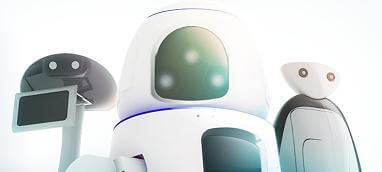
What if your iPhone suddenly sprouted arms and started speaking? You’d end up with something close to A-Star’s newest line of social robots. Recently seen at Robocup 2010 in Singapore, the A-Star robots are sleek, stylish, and highly focused on human interaction. A-Star Social Robotics Lab (ASORO), which is based in Singapore, developed three models on display: a receptionist (Olivia), a telepresence robot (Lucas), and a household assistant (Mika). Each has their own unique skill sets, but all three aim to communicate and work more like humans. Friendly, exuberant humans. I guess that since we’re social creatures it makes sense that our robots would need to be socialable too. We’ve got videos of these enthusiastic robots for you below. Check them out.
Commercial robots are getting more sophisticated, but it’s hard to know what to do with them. With appliance-like robots it’s clear: set them to cleaning your floor, or some other repetitive task, and let them do their jobs. Humanoid bots, however, are still working up to actually serving alongside humans. The number of tasks they can successfully accomplish is very specialized. Bots like the iFairy from Kokoro can perform a marriage ceremony…but what do you do with it when it’s not acting like a minister?
ASORO seems to have taken the approach of making robots that are human-focused first. Olivia, the receptionist, is very verbal, with gesticulating arms that let it express itself as people often do – with their hands. Mike listens and follows commands to serve as an extra arm around the home or office. Lucas is a tele-robot, it’s essentially taking the place of a human that needs to tele-commute somewhere. In each case accomplishing tasks seems to somewhat take a back seat to being attractive and social.
As you’ll see in the following video at Robocup 2010, Olivia follows people’s faces, understands speech to some degree, and can respond with appropriate voice recordings. That fits with its role as a receptionist or other greeter. Its hardware is appropriately sensor-heavy. Olivia has 8 microphones in its head alone to help isolate human voices, it has stereoscopic vision and a monocamera it uses to track faces. It also has all the typical guidance systems (laser range finder, bumpers, etc) in its base to help it move around. The things you’ll probably notice first about Olivia, however, is that it has arms that it uses, quite adeptly, for talking. With six degrees of freedom in each arm and six more in each hand (not seen in the videos below), Olivia can make some fairly human like gestures, as you’ll see:
There is something about arm movements that really draw humans into social interactions. As we saw with the MeBot tele-robot from MIT, even some simple body language can really help people understand and relate to machines. If Olivia’s gestures seem particularly life-like and enjoyable, it’s probably because ASORO taught them to her by hand. The following video demonstrates that gesture programming process:
But what if Olivia had arms that were more focused on utility than speaking? Then you’d have Mika. Another one of ASORO’s social creations, Mika follows commands and can even fetch you a cup of coffee. Not the coolest thing that a robot has ever brought a human, but it’s still pretty neat to watch:
Lucas, ASORO’s tele-robot is not as autonomous or well-armed as its counterparts, but it’s a telepresence tool. The social aspect of its creation is likely to be directly guided by the operator sitting at a computer using it to telecommute. Even here, though, A-Star gives its bot some charm. Lucas’ video screen pops up out of its base like a much classier robot version of Oscar the Grouch. You can see an animation of this at the ASORO website.
The eventual use for these types of robots is still very uncertain. Will we see these robots in the homes of the elderly, turning off lights and fetching coffee? In the short term I think the answer is ‘no’. Reliably grasping and moving objects still seems to be a task in the research phase for robotics. Social interactions, however, are much closer to market. Receptionist is probably the perfect role for these bots and Olivia seems the most likely to succeed. We’ve already described how robots can be used as greeters and guides in corporate buildings. Kokoro’s iFairy is also marketed as serving that purpose. Of course, such applications are going to be very limited for a while. Not every company is going to want or need a robot receptionist. Still, giving humans a presence to talk to, (maybe even relate to), seems like a reasonable goal. It will take a long time before humans are as comfortable interacting with robots as they are with other humans, but these friendly robots by ASORO are a step in the right direction. Who knows, in a few years these robots may be less socially awkward than I am. Maybe I should start waving my hands more when I talk…
[image credit: ASORO]
[source: ASORO, Robocup 2010]


